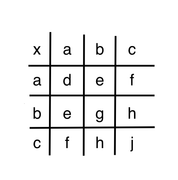AbeNeedsAnswers wrote:
In the multiplication table above, each letter represents an integer. What is the value of c?
(1) c = f
(2) h not= 0
We need to determine the value of c. Following our table, we have:
a x c = f
b x c = h
and
c^2 = j
Statement One Alone:
c = f
Since c = f, we have:
a x c = c
ac - c = 0
c(a - 1) = 0
c = 0 or a = 1
We see that either c = 0 or a = 1 (if c ≠0). Since we don't know whether c is 0, we cannot determine the value of c. Statement one alone is not sufficient to answer the question.
Statement Two Alone:
h ≠0
Since h is not zero, neither b nor c is zero. However, we still can't determine the value of c. Statement two alone is not sufficient to answer the question.
Statements One and Two Together:
Using statement two, we know that c ≠0, and thus from statement one, a = 1. However, c can be any nonzero number, so we still cannot determine a value for c.
Answer:
E


